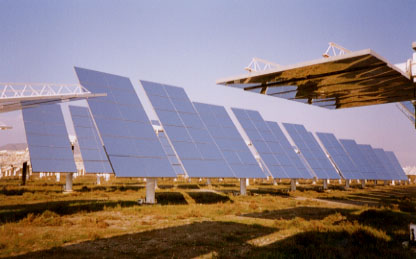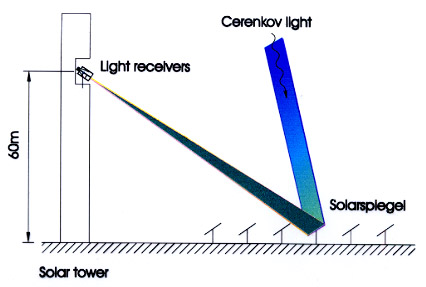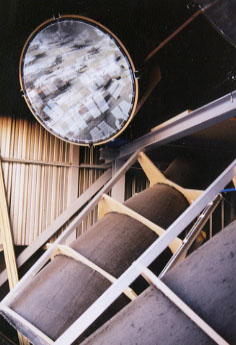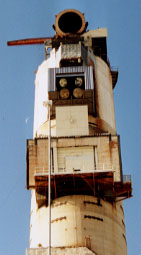 GRAAL
project
GRAAL
project
 GRAAL
project
GRAAL
project


GRAAL is presently taking data in each clear and moon less night and the basic possibilities and problems of the light-sampling approach when using heliostat fields have been understood.
 the final version of GRAAL was set up at the PSA in 1999. The
final - remotely controlled - setup went into operation in 2000. In case
the control program detects technical problems, a remote operator is informed
via mobile telephone and can take corrective action via the internet. The
detector consists of four large light collectors, so called ``Winston cones'',
which concentrate incoming light onto large-size photo multipliers. These
cones have windows of 108 cm diameter and are mounted inside a protecting
hut at 70 m height in the central tower of the solar field. Each
cone points onto a different region of the heliostat field and collects
the signals of 13-18 heliostats onto a single photo multiplier. The
windows size of the collectors limits the angle acceptance angle
of the detector to a rather small 0.6 degrees (full angle). For the individual
control of the heliostats used by GRAAL a dedicated computer program was
developed by the Spanish groups. Each heliostat sends a signal of
about 4 ns width and with an amplitude determined by its received
light to one of the cones. Due to the different distances of the individual
heliostats from the collectors the signals reach the read-out electronics
at different times and are individually registered by flash ADCs. This
principle allows the detection of light from 63 heliostats with only 4
data-taking channels. It is this principle that leads to the cost saving
mentioned in the introduction.
the final version of GRAAL was set up at the PSA in 1999. The
final - remotely controlled - setup went into operation in 2000. In case
the control program detects technical problems, a remote operator is informed
via mobile telephone and can take corrective action via the internet. The
detector consists of four large light collectors, so called ``Winston cones'',
which concentrate incoming light onto large-size photo multipliers. These
cones have windows of 108 cm diameter and are mounted inside a protecting
hut at 70 m height in the central tower of the solar field. Each
cone points onto a different region of the heliostat field and collects
the signals of 13-18 heliostats onto a single photo multiplier. The
windows size of the collectors limits the angle acceptance angle
of the detector to a rather small 0.6 degrees (full angle). For the individual
control of the heliostats used by GRAAL a dedicated computer program was
developed by the Spanish groups. Each heliostat sends a signal of
about 4 ns width and with an amplitude determined by its received
light to one of the cones. Due to the different distances of the individual
heliostats from the collectors the signals reach the read-out electronics
at different times and are individually registered by flash ADCs. This
principle allows the detection of light from 63 heliostats with only 4
data-taking channels. It is this principle that leads to the cost saving
mentioned in the introduction.
The delay between the individual signals depends on the shower direction.
The arrival times are measured with a precision < 500 ps. This makes
it possible to reconstruct the shower front in time and thus measure
the shower direction independent on pointing direction. The energy threshold
is limited mainly by the night sky background (NSB); the direct star
light or scattered light generates noise signals in the PMT´s.
With a trigger electronics consisting of charge integrators followed
by threshold discriminators  and a 3 out of 4 coincidence the true showers are selected with a
rate of 2 to 4 Hz, depending on weather conditions and zenith angles.
and a 3 out of 4 coincidence the true showers are selected with a
rate of 2 to 4 Hz, depending on weather conditions and zenith angles.
GRAAL takes data continuously since August 1999. Losses of observation time due to technical problems were only a few percent. The main source of losses were unstable weather conditions due to the relatively low elevation and closeness to the sea of the PSA and dew formation on the mirrors. The latter problem was improved by the installation of an dew prevention procedure in spring 2000.
From a comparison of pointing direction and reconstructed direction from the timing analysis we find an absolute precision of the pointing < 0.05 degrees for both zenith and azimuth angles. From Monte-Carlo simulations we get an angle resolution for Gammas (from MC) = 0.35 degrees at zenith angle 10 degrees and azimuth angle 45 degrees and an energy threshold for the detection of gamma-ray (defined as energy of particles contributing the maximal count rate of analyzed showers) of ca. 250 GeV.
Detailed comparison of data and Monte Carlo simulations show that the mentioned small angular acceptance - practically unavoidable when using solar mirror fields - leads to time structure of proton induced showers which is nearly identical to the one of gamma induced showers. This makes gamma-hadron separation - crucial both for enhancing the sensitivity and inferring absolute fluxes - difficult. Moreover, the small acceptance angle leads to a bias even the determination of the incoming direction for proton induced showers.
For confirmation of the principle function of the detector the well
known Crab pulsar was observed in spring 2000 for about 64 hours in total.
After filtering the data with weather criteria only 7 h and 10 min
of good data remained for ON and the same time for OFF position (total
of ca. 140000 events taken). From these data an excess of 4.5 sigma
in the central region (< 0.7 degrees deviation from source direction)
- corresponding to a Gamma flux of 1.7/min - was measured. Furthermore
data on the potential sources 3C 454.3, 3EG 1835+59 and a ``pseudo source''
(for test purposes) was taken. None of these sources showed a significant
excess compared to the OFF position. Data taking continued
until end of 2001 when the
project was finished as planned. The final reports for the project
(see publication section on main page) were the first documents to explain
why the heliostat-field approach to gamma-
ray astronomy is not competitive to the imaging approach. The other
heliostat-field projects, with total costs about an order of magnitude
higher than GRAAL have still to supply
such information at the time of the most recent update of this page
(July 2002).